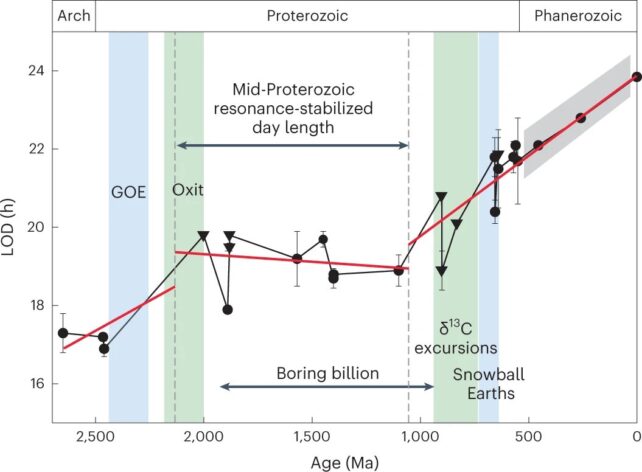There was a time in Earth's turbulent history when everything almost slowed to a standstill. Tectonic activity eased, geochemical processes oozed, and the evolution of life in its simplest forms didn't do a whole lot.
Now new research suggests this period of not much – affectionately called the 'boring billion' – coincided with a time when planet Earth was suspended in a steady state of constant rotation, an orb pirouetting in space with one day (one revolution) taking just 19 hours.
This 'stalling' of Earth's day length at 19 hours lasted roughly 1 billion years and was the result of a delicate balance of opposing forces in our planet's distant past, the study from two geophysicists suggests.

At the time, the Moon was closer to Earth and hovering at a constant distance, not slipping out of its gravitational embrace like it did before and has done since.
"Over time, the Moon has stolen Earth's rotational energy to boost it into a higher orbit farther from Earth," Ross Mitchell of the Chinese Academy of Sciences and Uwe Kirscher of Curtin University in Australia explain in their published paper.
As a result of the Moon's outward movement, Earth's rotation slows, and our sunlit days lengthen ever so slightly – not that we notice the itty-bitty addition to our 24-hour-long daily spins.
Plenty of past research has explored how our planet's days slowly get longer, at a tick over 0.000015 seconds per year, by some recent estimates.
Most models of Earth's rotation in studies like this predict that day length on our home planet has steadily increased over the past 3 to 4 billion years. A 2018 study, for example, found that one Earth day 1.4 billion years ago clocked in at 18 hours long.
Though there is another camp of researchers who have speculated – since as far back as 1987 – that perhaps Earth's day length flatlined for an extended period before resuming its slow, steady increase up to the 24 hours we today call a day.
But any geological trace indicating a change in Earth's rotation is hard to come by. The length of day can be inferred from the growth of stromatolites tilted toward the Sun and from tidal rhythmites, patterns of mud sediments laid out by tides and preserved in rock. Except these are rarely preserved into the distant past.
In this new study, Mitchell and Kirscher took advantage of a flurry of new geological data that has emerged in recent years. The cyclostratigraphy data are records of rhythmic changes in Earth's climate driven by astronomical forces, including Earth's wobble and axial tilt.
"We realized that it was finally time to test a kind of fringe, but completely reasonable, alternative idea about Earth's paleorotation," says Mitchell.
Their statistical analysis points to a flatlining of Earth's day length between 2 and 1 billion years ago, in the middle of the Proterozoic era, which climaxed with 'Snowball Earth' and preceded the Cambrian explosion of life.
Wondering what may have tripped early Earth into a period of relative stability, Mitchell and Kirscher looked to other major events in our planet's rocky history.
If their timing is correct, the plateau in day length followed significant fluctuations in early Earth's atmospheric conditions: specifically, the Great Oxidation Event in which oxygen levels rose and created an ozone layer before dropping off again.
Mitchell and Kirscher say this added ozone could have absorbed more sunlight than water vapor, exciting Earth's lesser-known solar tides that pulse in the atmosphere as it heats up during the day.
Solar atmospheric tides are not as strong as oceanic tides governed by the gravitational pull of the Moon. But when planet Earth spun faster in the past, the Moon's tug would have been weaker – one-fourth of its current strength.
And if atmospheric tides sped up with an injection of ozone and sunlight, as Mitchell and Kirscher suggest, this may have been enough to balance out the opposing forces and lull Earth into a very long stable period of 19-hour days.
"At the point of resonance, the oceanic and atmospheric tidal torques would balance, stabilizing Earth's rotation rate at a constant day length," Mitchell and Kirscher explain.
Of course, much more research is needed to "further test and more accurately determine the resonance period", Mitchell and Kirscher note.
Though the duo concludes that their work is consistent with the idea that the rise of oxygen levels and complex life on Earth were delayed "until the resonance was broken" by a sudden climatic change.
"Longer days could [then] provide photosynthetic bacteria with sufficient sunlight to raise oxygen levels high enough to support large Metazoan life," they write.
But if our growing understanding of the 'boring billion' is anything to go by, expect these estimates of early Earth's daily rotation to shift as more evidence comes to light.
Some researchers in recent years have argued that the boring billion was far more dynamic than its name suggests, and its fertile ground provided a 'slingshot' towards complex life that we still marvel at today.
The study has been published in Nature Geoscience.
